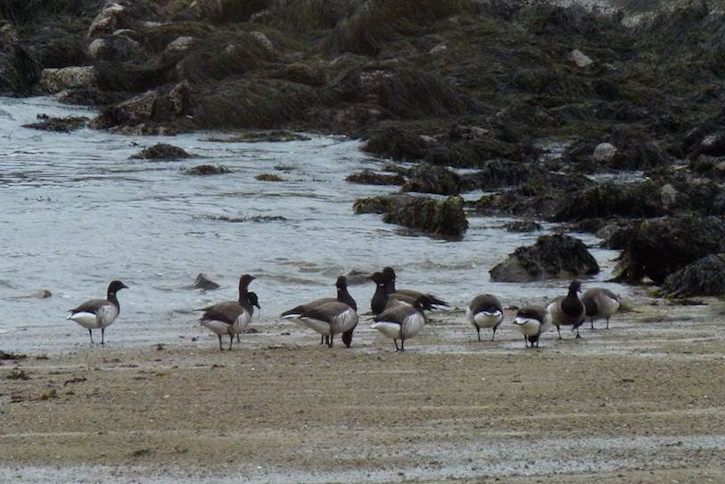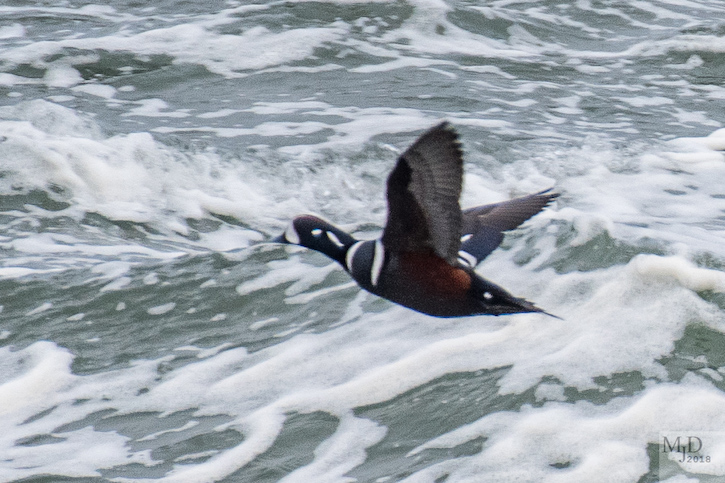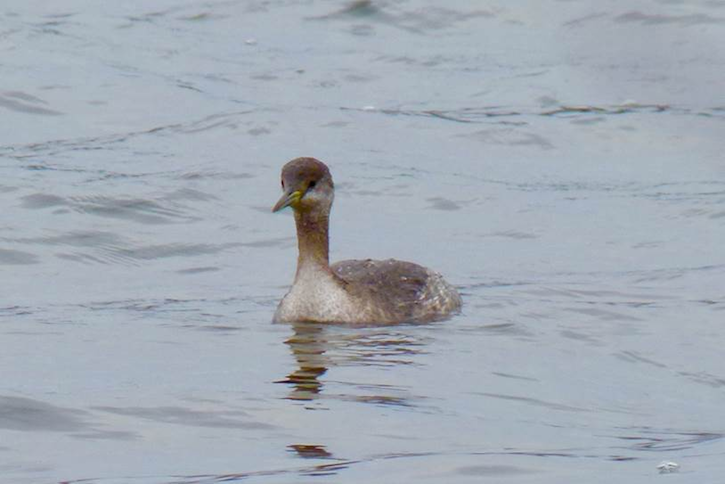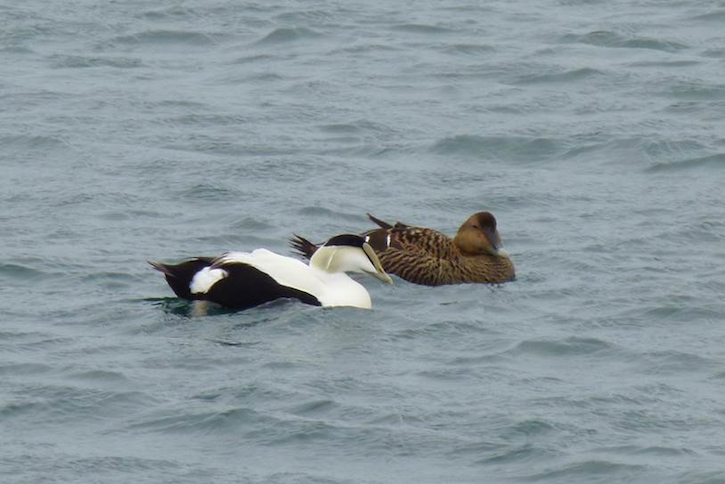Dave Weaver and I met birders on Wednesday who were convinced that the “four’easter” snowstorm was really a snow job. We were all excited to have another shot at this productive winter season on our favorite knob of rocks. Since the forecast was for winds of dramatically increasing intensity, we ran around the cape in the reverse of our usual order, beginning with Plum Cove. While there was only a kind of “funny-looking” goldeneye in the cove, not the beautiful male Barrow’s that has wintered there, there were lots of other birds, beginning with a large flock of Brant. They were grazing placidly on algae they found on exposed rocks, or stood on the sand gazing about philosophically. We love Brant, and wish we could learn a way to recover eel grass beds that once helped make them more abundant. The cove was picturesque with the low tide and plenty of other birds — Bufflehead, Red-breasted Mergansers, a few White-winged and Black Scoters at the mouth and further out, and a little group of female Greater Scaup playing hide-and-seek with us among rocks on the lip of the cove. When we first arrived, our first of seven Iceland Gulls flew by, one of six immature birds. Long-tailed Ducks raced back and forth as usual out over the open water.

Brant at Plum Cove – Jaqueline Miller
With all that encouragement, and given the relatively sheltered spot, we were ready for the onslaught sure to greet us at Andrews Point. The gale did not disappoint! We had to lean a good bit forward to get out to the end of the path, and could see that it would be a bit dicey for seeing bird life. I provided minor comic relief with my public debut of some goggles I’ve discovered to cut the wind on these occasions. They were made to help cooks avoid onion fumes, and do a great job against the outer elements, allowing optics just close enough to the eyeball. They look ridiculous, but allowed me to see that the many Harlequin Ducks, staying prudently away from the surf churning on the rocks, would not be in optimal view! You’ll notice below that we didn’t have much luck with anything else out there, but felt quite invigorated.

Harlequin Duck – Mike Densmore
Cathedral Ledge was a bit better, and we could see the many Harlequins there much better. Two more Iceland Gulls whipped by at that spot, but again, the rough water either obscured or repelled birds we might have otherwise looked for there. As we moved on to Rockport Harbor. The idea that something unusual could be sheltering there spurred us on. Indeed, upon pulling in, a Horned Grebe sat on the calm surface of the harbor. We got lots of good looks at that handsome little guy.

Iceland Gull – Juvenile – Mike Densmore
The next question was whether Atlantic Road would be protected by the headlands of the cape as it was last weekend. Alas, not so much, but when we approached the Elks Club, another immature Iceland Gull, close in and hovering on the edge of the water, then an adult and another immature. It was white-winged gull fever! Those three birds flew back and forth beautifully for us while we enjoyed the spectacle of the sea and the birds tossin g around on and above it. There were the usual Buffleheads, eiders, and scoters, just not as visible as they often are. Only one juvenile Great Cormorant stood on “Cormorant Rock” perhaps having missed the memo?

Iceland and Ring-billed Gulls – Mike Densmore
At Niles Pond, there were lots more birds, as we expected. A big flock of Herring, Ring-billed, and Great Black-backed Gulls sheltered with one – you guessed it – immature Iceland floating among them. Red-breasted Mergansers, several Ring-necked Ducks, Mallards, a Mute Swan, and one Red-necked Grebe made for interesting viewing.

Red-necked Grebe on Niles Pond – Jaqueline Miller
With a bit of time left for Gloucester Harbor, our hopes for one more alcid for this winter season of WMB were high. There were nice birds close to us at Jodrey Fish Pier — lots of Common Eiders, and a little raft of Long-Tailed Ducks and Greater Scaup. A Common Loon performed. Then there it was, a little black-and-white football, a Thick-billed Murre, bobbing out among the buoys. Yay!

Common Eiders in Gloucester Harbor – Jaqueline Miller
Our list:
Brant (~ 24) – ~ 16, Plum Cove; ~ 8, Front Beach, Rockport.
Canada Goose
Mute Swan (1) – ad., Niles Pond.
American Black Duck (~ 35)
Mallard (~ 20)
Ring-necked Duck (7) – Niles Pond.
Greater Scaup (~ 16) – ~ 6, Plum Cove; 10, Jodrey Fish Pier.
Common Eider – common.
Harlequin Duck (~ 50) – ~ 25, Andrews Pt.; ~25, Cathedral Ledge.
White-winged Scoter – common.
Black Scoter (~ 10) – Andrews Pt.
Long-tailed Duck (19) – 8, flyby, Plum Cove; 11, Jodrey Fish Pier.
Bufflehead (~ 49) – ~ 15, Plum Cove; ~ 30, Bass Rocks; 4, Niles Pond.
Common Goldeneye (7) – 5, Plum Cove; 2, Bass Rocks.
Barrow’s Goldeneye – possible 1st-winter male, Plum Cove.
Red-breasted Merganser – common.
Common Loon (4) – 1, Plum Cove; 1, Eastern Pt. Blvd; 2, Jodrey Fish Pier.
Horned Grebe (1) – Rockport Harbor.
Red-necked Grebe (1) – Niles Pond.
Great Cormorant (2) – 1 imm., “cormorant rock,” Atlantic Rd; 1 imm.,
Niles Pond.
Turkey Vulture (2) – marsh, Rt 127A, Rockport.
Ring-billed Gull
Herring Gull
Iceland Gull (7) – 1-1W, Plum Cove; 2-1W, Cathedral Ledge; 2-1W & 1 ad
(appeared to be /L. g. glaucoides/ – absolutely pure-white wingtips),
Bass Rocks (Elks Club); 1-1W, Niles Pond. The Bass Rocks birds were a
treat to watch as they foraged in the surf.
Great Black-backed Gull
Thick-billed Murre (1) – Jodrey Fish Pier.
Rock Pigeon
American Crow (~ 30)
Black-capped Chickadee (1)
Tufted Titmouse (2) – Plum Cove.
American Robin (~ 10) – Plum Cove.
European Starling
Song Sparrow (1) – Plum Cove.
Dark-eyed Junco (2) – Plum Cove.
Northern Cardinal (3) – 2, Plum Cove; 1, Niles Pond.
Red-winged Blackbird (1) – Niles Pond.
House Finch (5) – Plum Cove.
American Goldfinch (1) – Plum Cove.
House Sparrow

